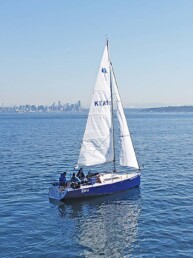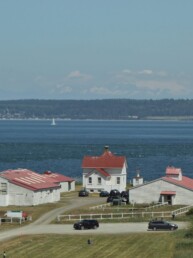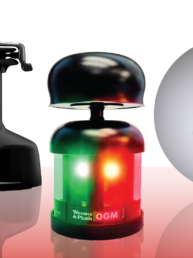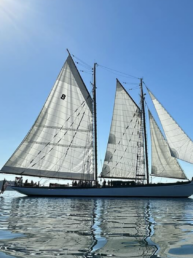Here’s our latest destinations installment courtesy of SalishSeaPilot.com‘s Jim Burgoyne detailing four anchorages south of Cape Caution good for waiting for a weather window to round.

and Skull Cove (right) carved into Bramham Island. (Photo by gdybdal.)
Cape Caution has earned the warning in its name. Sea conditions, especially in wind-against-current situations, can be extreme in the waters off the cape which should be avoided during these times.
But four anchorages just south of the cape provide mostly excellent protection for boaters awaiting suitable conditions to round the headland and begin their exploration of BC’s central coast.
The anchorages along the north shore of Queen Charlotte Strait are within 10-14 nautical miles of the cape, making them convenient to reach anchorages to the north so boaters can limit the time they are exposed to the open sea and accompanying swell.
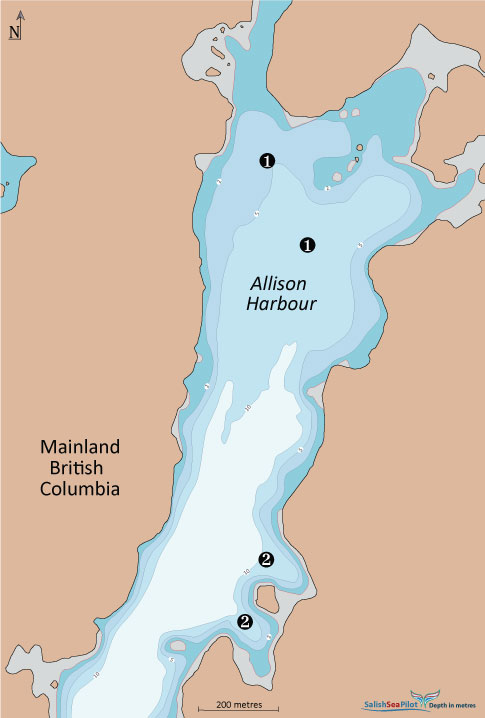
One of our local favorites, with excellent protection, good depths and generous swing room, is Allison Harbour. The 1.5nm-long inlet is the easiest anchorage in the area to enter, especially in foggy conditions common in the late summer.
Originally called False Bay or False Schooner Passage, in the 1930’s the inlet came to be named after coastal logging magnate A.P. Allison. In the 1920’s, a float community of mostly loggers established a post office, rooming house and café. Soon it became a scheduled stop for the Union Steamship Company. A store, marine fuel station and sawmill, all on floats, were added to the mix.
Local optimism for the future of the harbour faded and the last businesses closed their doors in the early 1950s. As the last permanent residents moved on, most evidence of human occupation was slowly, but relentlessly, swallowed up by the Great Bear Rainforest.
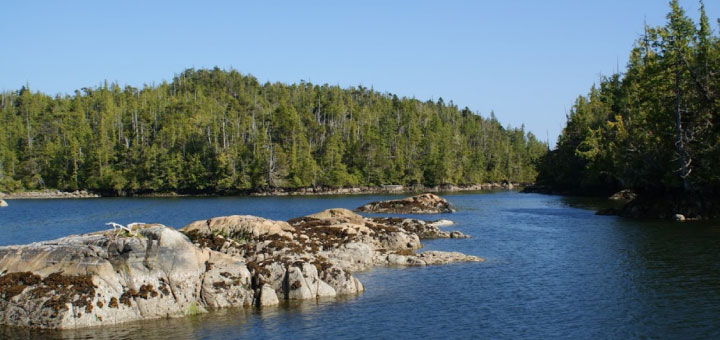
Today, a few traces of human activity, such as wooden posts and rusted booming cables, remain. In recent years, a small cabin was built on the islet at the head of Allison Harbour. In 2008, a 132-hectare tract of land was acquired by the province and the Allison Harbour Marine Park was established.
On entry from the south, there are several bights along the east and west shores of the inlet offering secure anchorage. We have not anchored in all possible sites, but found moderate to excellent holding in mud where we did drop a hook.
The head of the harbour offers the most room to anchor and the islet and sandy beaches here are fun to explore by dinghy.
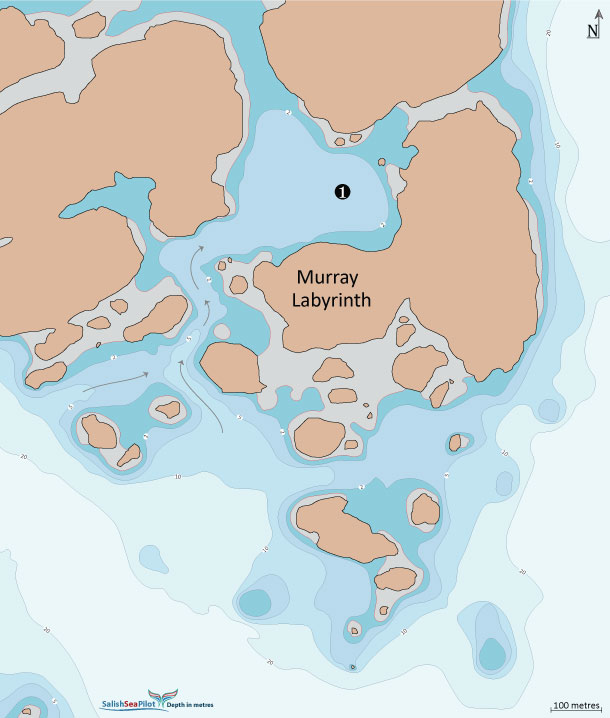
A nautical mile outside the entrance to Allison Harbour is a more unnerving anchorage to enter: Murray Labyrinth. This anchorage, amid a cluster of little islands, is found by following a narrow, zig-zagging unmarked channel from the southwest with rocks and islets close on either side.
The first time we entered the anchorage on a dark, gloomy afternoon, it wasn’t without hesitation. But we took things slow, with Lynne on the bow and me at the helm, nervously scanning the depth sounder, the chart plotter and the nearby rocks.
The anchorage can also be reached by a channel from the north, we are told. It is shallower still and best attempted on a rising tide. We have yet to test it, opting to stick with the entrance we know.
Once inside, the anchorage is magical, with excellent shelter. Winds that threatened a gale out in the strait were just a flutter in a burgee at our spreader.
On entry, keep south of a charted rock near the centre of the bay, anchoring in the southeast of the cove. From here, the many islets and coves in the vicinity of Murray Labyrinth are a wonder to explore by dinghy, kayak or SUP.
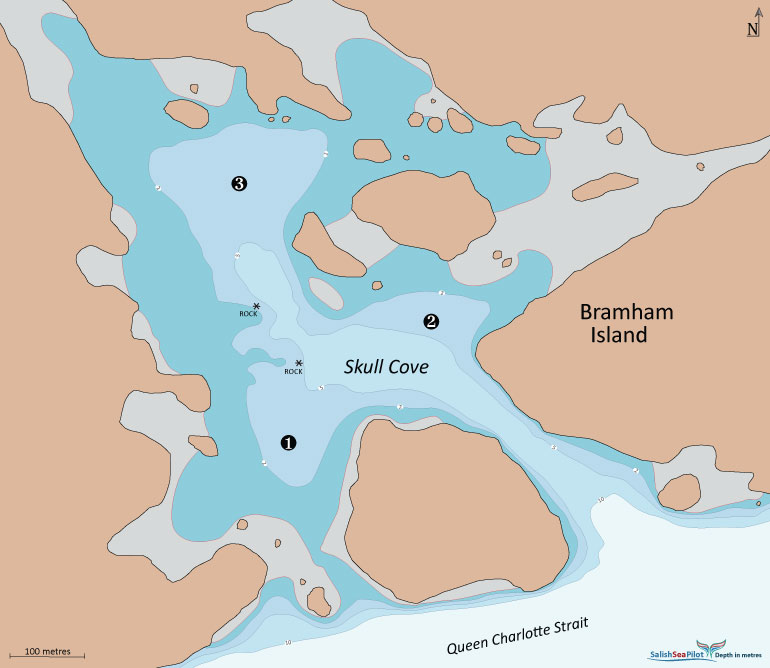
Once settled in, anchor set, a sundowner in your mitts, it’s hard not to feel a sense of satisfaction and any apprehension felt before entry is soon forgotten. You might never want to leave.
About a nautical mile closer to Cape Caution is Skull Cove, which is either bulletproof or a wind tunnel depending with whom you are talking.
In settled conditions, it is lovely place to sit on a hook anywhere in the cove and the holding is good. But when the wind is up the only secure anchorage is in the southwest corner – turn left on entry to the cove. The views from here out to the Deloraine and Eliza islands, and the strait beyond, are really quite beautiful.
Elsewhere in the cove, particularly northwest of two central islets, with a gale in the strait you are likely to be awake all night listening to the wind crying in your rigging while watching your electronics for signs of dragging.
Most of the time, a great anchorage; sometimes, not so.
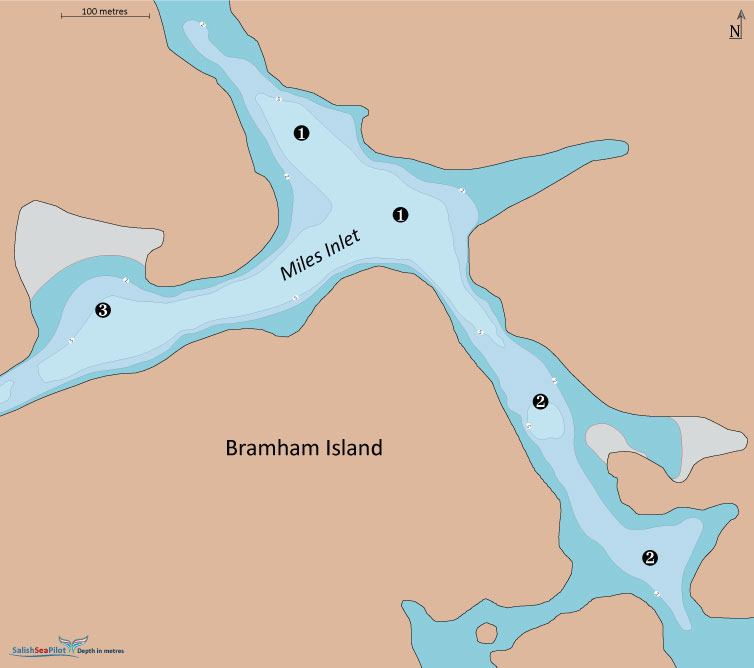
Another anchorage option is Miles Inlet, the closest of this quartet to Cape Caution. From the southeast of Bramham Island, the narrow, unobstructed waterway cuts straight into the island for about 1nm. Excellent protection is found turning to port or starboard at the T-intersection near the head of the inlet.
The swing room is limited anywhere in Miles Inlet, but the shallow depths do not call for much scope on your anchor rode and the holding is good in mud. As well, much of the shoreline allows easy access for tying a stern line to shore.
The lagoons at the end of the branches of Miles Inlet are great fun to explore by dinghy or kayak. You never know what you will find, but take care to not find yourself trapped in the shallows at low low tides.
Whether heading north or south around Cape Caution, the four anchorages are close enough to the notorious waters to allow for a quick rounding of the cape and to provide excellent protection even if weather forecasts are wrong or encouraging ones are short lived.
Stay safe.
Note: This article was originally published on SalishSeaPilot.com.


